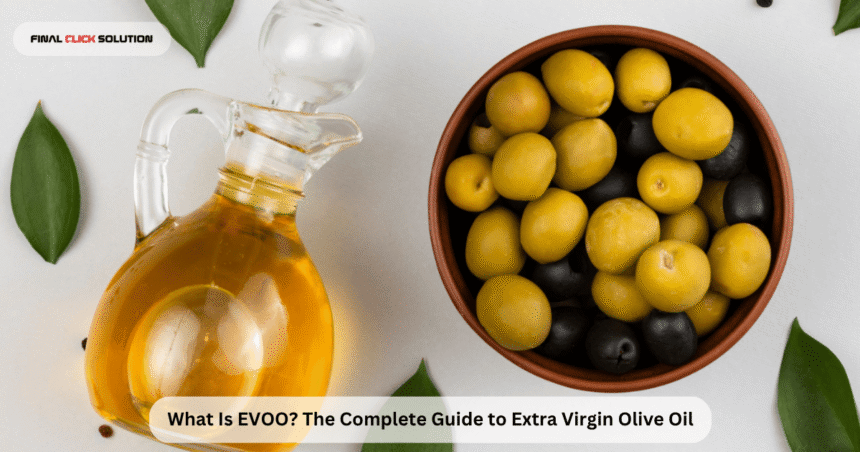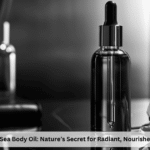When it comes to healthy cooking oils, few can compete with the versatility, flavor, and nutritional benefits of EVOO, also known as Extra Virgin Olive Oil. You’ve probably seen bottles labeled “EVOO” on grocery store shelves or mentioned in recipes by celebrity chefs. But what exactly makes it special? Why do nutritionists and chefs alike praise it as one of the healthiest fats on the planet?
This comprehensive guide explores everything you need to know — from how EVOO is made and what sets it apart from other oils, to its uses, benefits, and even tips on how to choose a high-quality bottle. Whether you’re a home cook, a health enthusiast, or simply curious about what is EVOO, this article will give you a deep understanding of this golden elixir.
1. Understanding EVOO: What Does It Mean?
EVOO stands for Extra Virgin Olive Oil, the highest and purest grade of olive oil. The term “extra virgin” signifies that the oil is extracted from olives without the use of heat or chemicals — a process known as cold pressing. This gentle extraction preserves the oil’s natural flavor, aroma, and nutritional compounds.
In simple terms, EVOO is pure juice from fresh olives, much like fruit juice. It’s unrefined, unprocessed, and contains the full spectrum of healthy antioxidants and fatty acids found in the olive fruit.
To qualify as “extra virgin,” an olive oil must meet strict standards set by international bodies such as the International Olive Council (IOC) and the USDA. These standards include limits on acidity (below 0.8%), absence of defects in taste or aroma, and passing laboratory and sensory tests.
So, when you buy EVOO, you’re getting the most natural, nutrient-rich form of olive oil available.
2. A Brief History of Olive Oil and EVOO
The story of olive oil stretches back over 6,000 years. Ancient civilizations in the Mediterranean — particularly Greece, Italy, and Crete — cultivated olive trees not just for their fruit but for their sacred oil. Olive oil was used in cooking, medicine, cosmetics, and even in religious ceremonies.
The concept of extra virgin quality dates back to early pressing methods. Ancient producers noticed that the first cold press of fresh olives produced a superior oil — fragrant, flavorful, and pure — while subsequent presses yielded lower-quality oil. That first, unrefined extraction eventually became known as extra virgin.
Today, EVOO continues to symbolize purity, wellness, and culinary excellence across cultures. Its production, although refined with modern technology, still honors the same traditional values of quality and care.
3. How EVOO Is Made
The journey from olive to bottle is a meticulous process that determines the oil’s flavor and quality. Here’s how it happens:
Step 1: Harvesting
Olives are hand-picked or gently shaken from the trees at the peak of ripeness. Timing is crucial — too early and the oil will be bitter; too late and it may lose freshness.
Step 2: Cleaning and Crushing
Once harvested, olives are washed to remove dust and leaves, then crushed (including the pits) into a thick paste using stone mills or mechanical crushers. This releases the oil from the fruit.
Step 3: Malaxation
The paste is slowly stirred to allow tiny oil droplets to combine. This process, known as malaxation, enhances the yield and flavor.
Step 4: Cold Extraction
The paste is then pressed or spun in a centrifuge to separate oil from water and solids — all done without heat or chemical solvents. The result is fresh, pure extra virgin olive oil.
Step 5: Bottling
Finally, the oil is filtered (sometimes left unfiltered for a rustic taste), stored in stainless steel tanks away from light and heat, and bottled for sale.
Each stage is designed to protect the oil’s delicate flavor compounds and health-promoting nutrients.
4. EVOO vs. Regular Olive Oil: What’s the Difference?
Many people assume all olive oils are the same, but the truth is quite different. Here’s a quick comparison:
| Type | Processing | Flavor | Nutritional Quality |
|---|---|---|---|
| Extra Virgin Olive Oil (EVOO) | Cold-pressed, unrefined | Rich, fruity, aromatic | Highest antioxidants & nutrients |
| Virgin Olive Oil | Cold-pressed but slightly lower grade | Mild, less fruity | Still healthy, but less potent |
| Pure or Regular Olive Oil | Refined and blended | Neutral flavor | Lower nutrients, higher processing |
| Pomace Olive Oil | Extracted using heat and chemicals | Flat, bland taste | Least nutritional value |
In short, EVOO is the purest and most nutritious form, while refined versions are more suitable for high-heat cooking or neutral taste preferences.
5. The Nutritional Power of EVOO
EVOO is not just a cooking ingredient — it’s a nutritional powerhouse packed with beneficial compounds that promote overall health.
Healthy Fats
EVOO is rich in monounsaturated fatty acids (MUFA), primarily oleic acid, which helps reduce bad cholesterol (LDL) while boosting good cholesterol (HDL). These fats also support heart health and reduce inflammation.
Antioxidants
It’s loaded with polyphenols, natural antioxidants that protect your cells from oxidative damage, slow aging, and fight inflammation.
Vitamins
EVOO contains vitamin E (for skin and immune health) and vitamin K (for bone and blood health).
Anti-inflammatory Compounds
One of the most powerful compounds in EVOO is oleocanthal, known for its anti-inflammatory effects similar to ibuprofen.
Together, these nutrients make EVOO a foundation of the Mediterranean diet, one of the world’s most studied and health-promoting eating patterns.
6. Health Benefits of EVOO
The benefits of EVOO go far beyond the kitchen. Numerous studies have shown that incorporating extra virgin olive oil into your daily diet can lead to measurable improvements in health.
1. Supports Heart Health
Regular consumption of EVOO is linked to lower risks of heart disease, thanks to its healthy fats and antioxidant properties.
2. Helps Reduce Inflammation
Chronic inflammation is a key driver of many diseases. The polyphenols in EVOO combat inflammation at the cellular level.
3. Promotes Brain Function
The antioxidants in EVOO protect brain cells from oxidative stress, potentially reducing the risk of Alzheimer’s disease and cognitive decline.
4. Aids in Weight Management
Despite being high in calories, EVOO can help control appetite and promote fat metabolism, especially when replacing processed oils or butter.
5. Supports Gut Health
EVOO promotes the growth of beneficial gut bacteria and supports a healthy digestive system.
6. Improves Skin and Hair
Its vitamin E and antioxidant content nourish the skin, combat dryness, and strengthen hair when used topically or consumed regularly.
7. Culinary Uses of EVOO
EVOO isn’t just healthy — it’s also incredibly versatile in the kitchen. Its flavor varies from peppery and grassy to smooth and buttery, depending on the olive variety and region of production.
Common Culinary Uses:
- Salad Dressings: Mix EVOO with vinegar, lemon juice, or herbs for a fresh, healthy dressing.
- Drizzling: Pour over pasta, grilled vegetables, or bread for a gourmet finish.
- Cooking: Ideal for sautéing or roasting at moderate temperatures (below 375°F / 190°C).
- Dips & Marinades: Combine with garlic, herbs, and spices for a flavorful dip or marinade.
- Baking Substitute: Use EVOO instead of butter for a lighter, moist texture in baked goods.
Pro tip: To retain its nutrients, avoid overheating EVOO — it’s best used for low to medium heat cooking or raw applications.
8. How to Choose Quality EVOO
With so many brands on the market, it’s important to know how to identify authentic, high-quality EVOO. Here’s what to look for:
1. Check the Label
Look for the term “Extra Virgin Olive Oil” and certifications from recognized bodies (like IOC, PDO, or USDA Organic).
2. Look for Harvest Date
Freshness matters. Olive oil doesn’t improve with age — the fresher, the better. Ideally, consume within 18 months of harvest.
3. Choose Dark Bottles
EVOO is sensitive to light and heat. Always buy oils packaged in dark glass bottles to protect against oxidation.
4. Note the Origin
Single-origin oils (from one region or estate) tend to have more consistent quality and flavor compared to blended ones.
5. Taste the Difference
Good EVOO should taste fresh, fruity, and slightly peppery — never greasy or odorless.
9. How to Store EVOO Properly
Proper storage is essential to preserve EVOO’s flavor and nutrients:
- Keep it in a cool, dark place, away from direct sunlight and heat.
- Seal the cap tightly to prevent oxidation.
- Avoid storing near the stove or in the refrigerator (cold temperatures can cause clouding but not spoilage).
- Use within 12–18 months of purchase for best quality.
10. Myths and Misconceptions About EVOO
Despite its popularity, there are still many myths surrounding EVOO. Let’s clear up a few common ones:
Myth 1: EVOO Can’t Be Used for Cooking
False. EVOO has a smoke point of around 375°F (190°C), making it perfectly safe for most cooking methods like sautéing and roasting.
Myth 2: The Color Indicates Quality
Color doesn’t determine quality — it simply reflects the type of olive and ripeness. Some high-quality oils are golden, others green.
Myth 3: All Olive Oils Are the Same
Not true. Refined oils lose much of their flavor and health benefits. Only EVOO delivers the full nutritional spectrum.
Myth 4: EVOO Lasts Forever
Even the best oils degrade over time. Always check the harvest date and store properly.
11. The Modern Popularity of EVOO
The global demand for EVOO has soared in recent years, thanks to rising health awareness and culinary innovation. It’s now a staple not just in Mediterranean households but in kitchens worldwide — from fine dining restaurants to home cooks seeking healthy alternatives.
In wellness communities, EVOO is often discussed in the context of anti-inflammatory diets, keto, and clean eating lifestyles. Its balance of flavor, nutrition, and versatility has made it a symbol of both health and sophistication.
In fact, when people ask what is evoo oil, they’re really asking about a product that bridges ancient tradition with modern wellness — a timeless ingredient that continues to evolve with our understanding of food and health.
12. Final Thoughts: Why EVOO Deserves a Place in Every Kitchen
To sum it up, EVOO (Extra Virgin Olive Oil) is much more than just a cooking oil. It’s a liquid gold that combines flavor, nutrition, and tradition in one bottle. From supporting heart health and reducing inflammation to enhancing everyday meals, its benefits are unmatched.
Choosing high-quality EVOO and using it properly can elevate your cooking while promoting long-term health. Whether you drizzle it on salads, bake with it, or simply enjoy it with bread, this pure and natural oil truly represents the best of nature’s offerings.
And for those wondering what is an evo, the answer lies in the same roots of excellence and purity — “EVOO” stands for “Extra Virgin Olive Oil,” the ultimate standard for freshness and quality.
So the next time you reach for a bottle of oil, let it be EVOO — the perfect blend of taste, tradition, and well-being.








